Are you tired of your dull, outdated bathroom? You’re not alone. A stunning shower can transform your entire bathroom experience. This guide will show you 15+ bathroom ideas with showers that’ll knock your socks off.
Ready for a splash of inspiration?
Key Takeaways
Corner showers and sliding door walk-ins save space in small bathrooms. Glass doors make rooms feel bigger.
Dual shower heads and rainfall showerheads add luxury. Rainfall heads cost around $250 and take about an hour to install.
Large format tiles (over 12 inches) create a sleek look with fewer grout lines to clean.
Frameless glass shower doors are stylish and easy to maintain. They’re made of tough tempered glass.
Barrier-free and low-threshold showers improve accessibility. Adding grab bars and non-slip surfaces boosts safety for all users.
Table of Contents
Optimizing Small Bathroom Shower Spaces
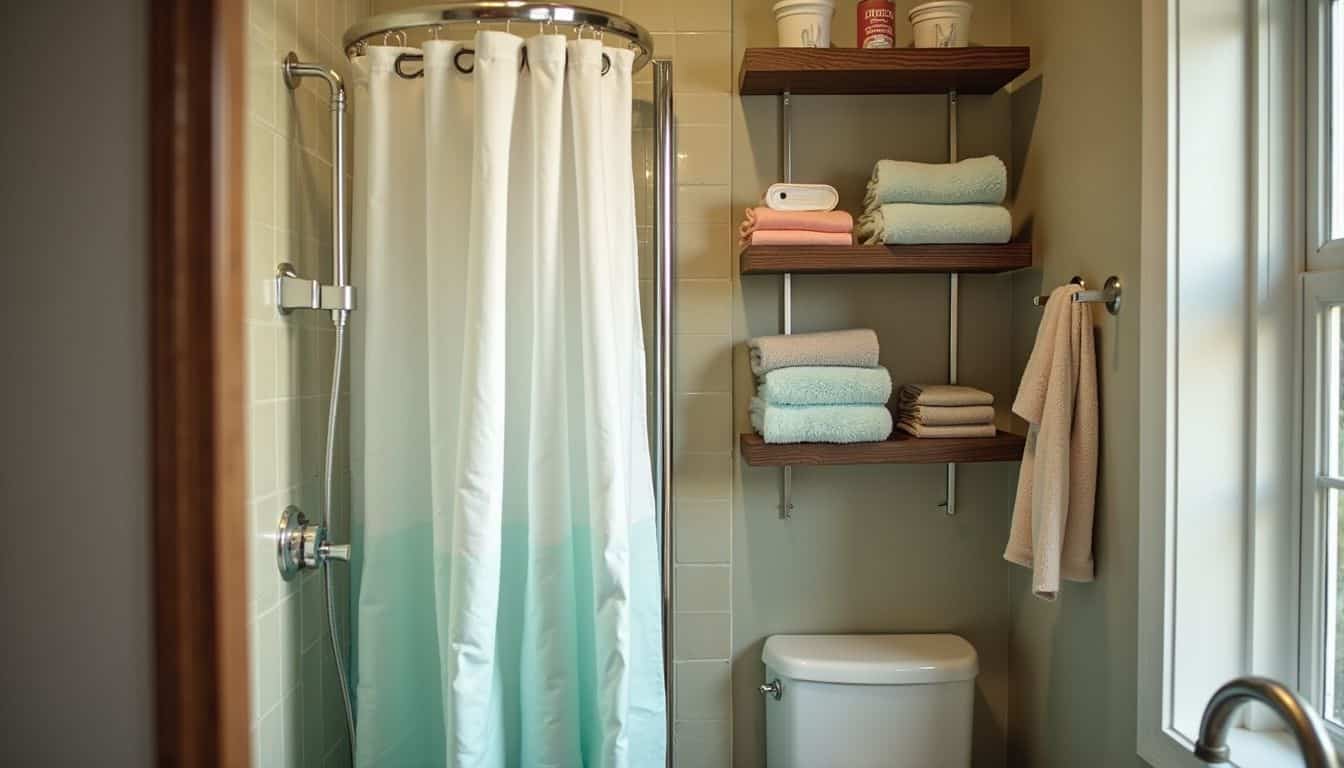
Small bathrooms can be a challenge. But with smart design, you can make your shower space feel bigger and better. Let’s explore some cool tricks to max out your tiny bathroom’s potential.
Corner Showers for Space Efficiency

Corner showers are a game-changer for small bathrooms. They fit snugly into tight spots, making the most of every inch. A sleek glass enclosure that doesn’t hog all your space – it’s like finding an extra closet in your apartment – pure gold.
These showers come in cool shapes too. Think triangles or curves that flow with your room’s layout. Glass doors are a smart pick here. They let light bounce around, making your bathroom feel bigger than it is.
A well-designed corner shower is like a Swiss Army knife for your bathroom.
Next up, we’ll chat about sliding door walk-ins – another space-saving champ.
Sliding Door Walk-In Showers

Moving from corner showers, let’s slide into another space-saving option. Sliding door walk-in showers are a game-changer for tight spots. They’re sleek, stylish, and oh-so-practical.
No need to worry about door swing – these babies glide smoothly along a track.
Guys, if you’re looking to upgrade your bathroom, sliding doors are the way to go. They save space and look great too. Plus, they’re easy to clean – no nooks and crannies for grime to hide.
And here’s a pro tip: opt for the advantages of frameless shower screens to really open up your space.
It’s like magic… your bathroom will feel twice as big! Just imagine stepping into that roomy shower after a long day. Pure bliss, right?
Adding Color and Light for Small Spaces
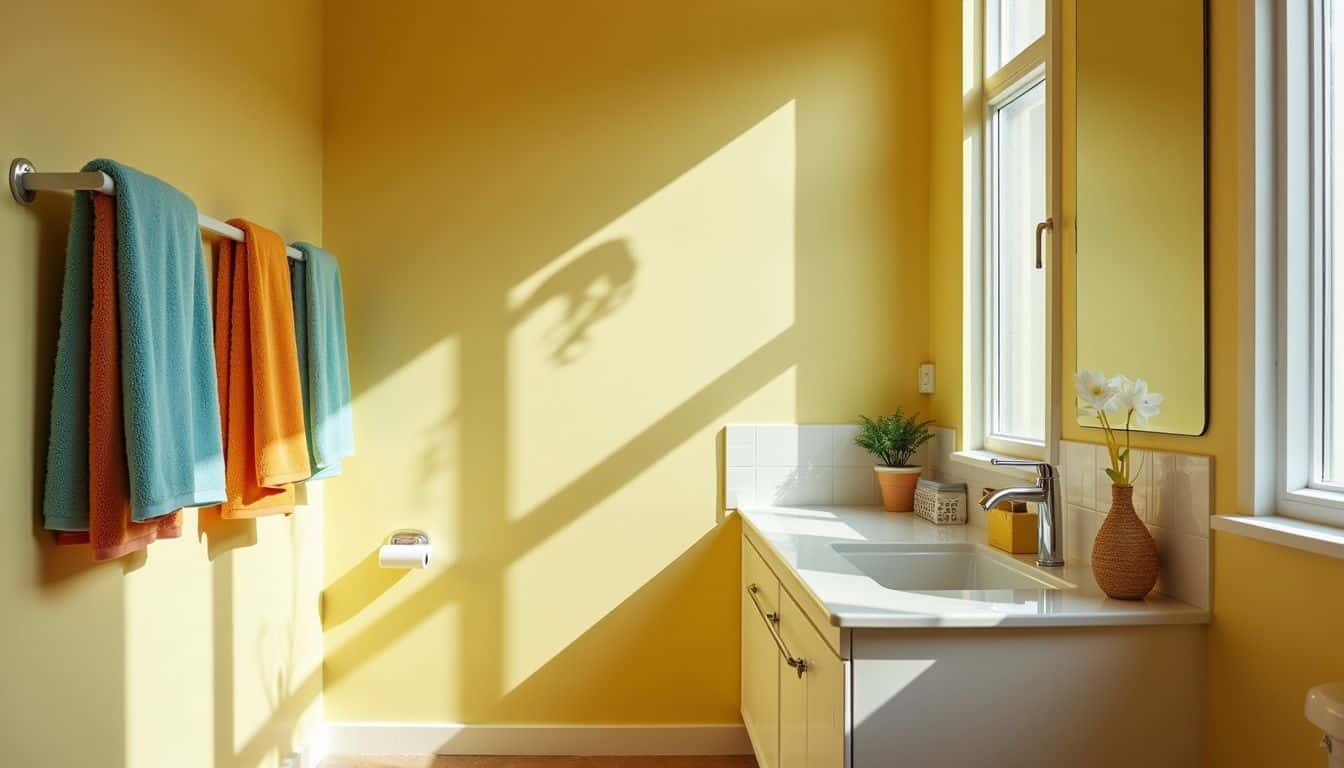
Small bathrooms don’t have to feel cramped. Bright colors and smart lighting can make your space feel bigger and more inviting. Try painting walls in light shades like soft blue or pale yellow.
These hues reflect light and open up the room. For a bold touch, add pops of color with towels or shower curtains.
Good lighting is key in small bathrooms. Install bright LED bulbs to banish shadows. A skylight can flood the space with natural light. If that’s not possible, large mirrors will bounce light around the room.
They also create the illusion of more space. With these tricks, your small bathroom will feel spacious and stylish.
Features of Luxury Showers
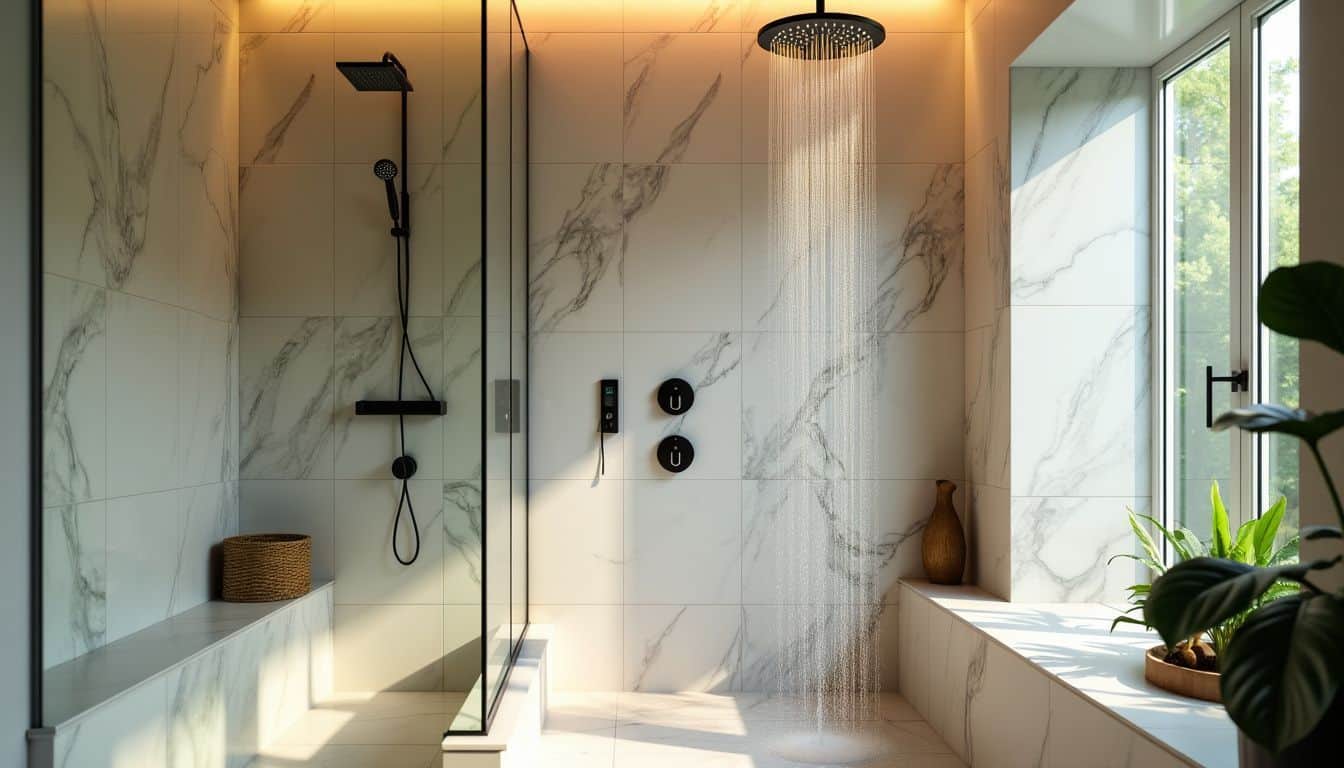
Luxury showers are all about pampering yourself. They’re packed with cool features that’ll make you feel like a million bucks every morning.
Dual Shower Heads for Enhanced Comfort
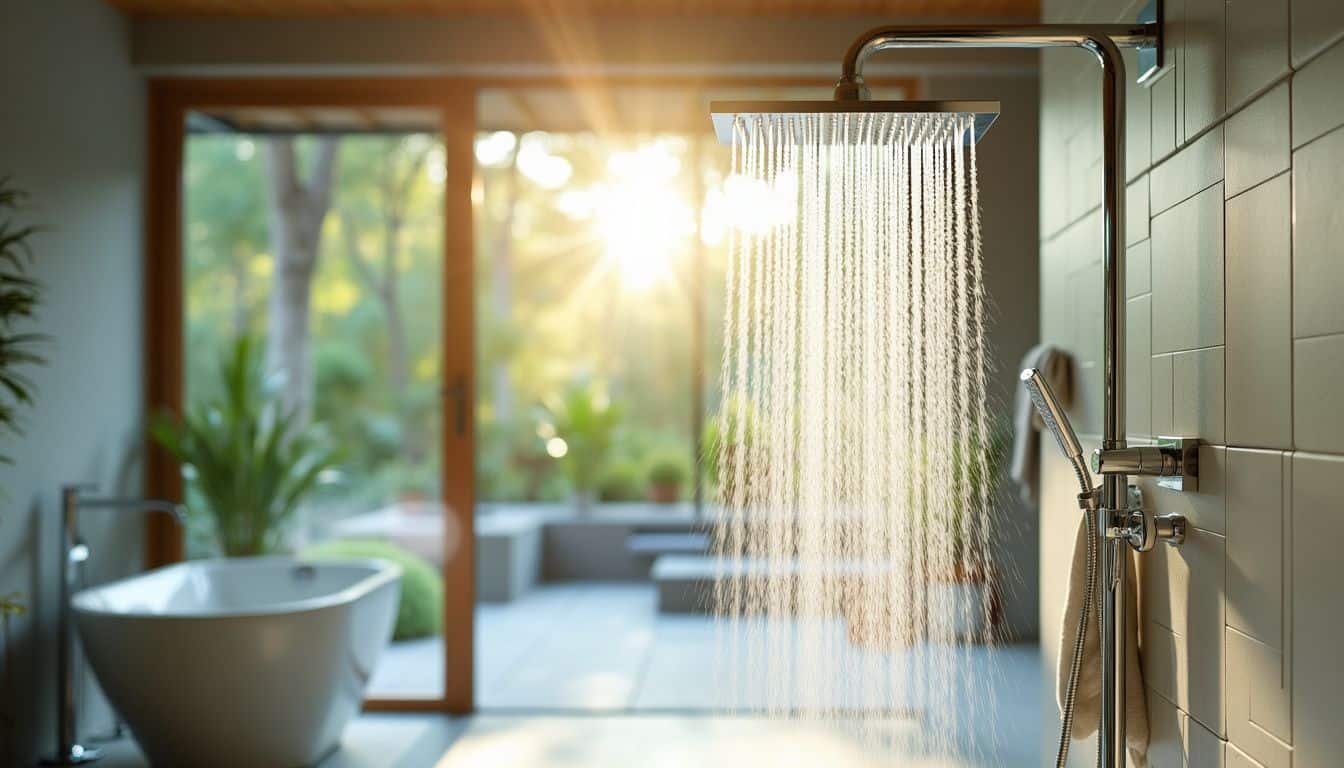
Dual shower heads are a game-changer for your bathroom… two streams of water hitting you from different angles – it’s like having your own personal waterfall right in your shower! These systems often come with a rain shower head for that luxe feel.
You can find heads ranging from 6 to 22 inches wide, bigger than most dinner plates!
I installed one of these in my bathroom last year… let me tell you, it’s worth every penny. Prices can vary from about $200 to $1,300. But the comfort? Priceless. It’s like getting a massage every morning.
Plus, you can adjust each head separately – one for rinsing shampoo, one for a soothing spray on sore muscles. Once you try it, you’ll wonder how you ever showered with just one head.
Installing Rainfall Showerheads
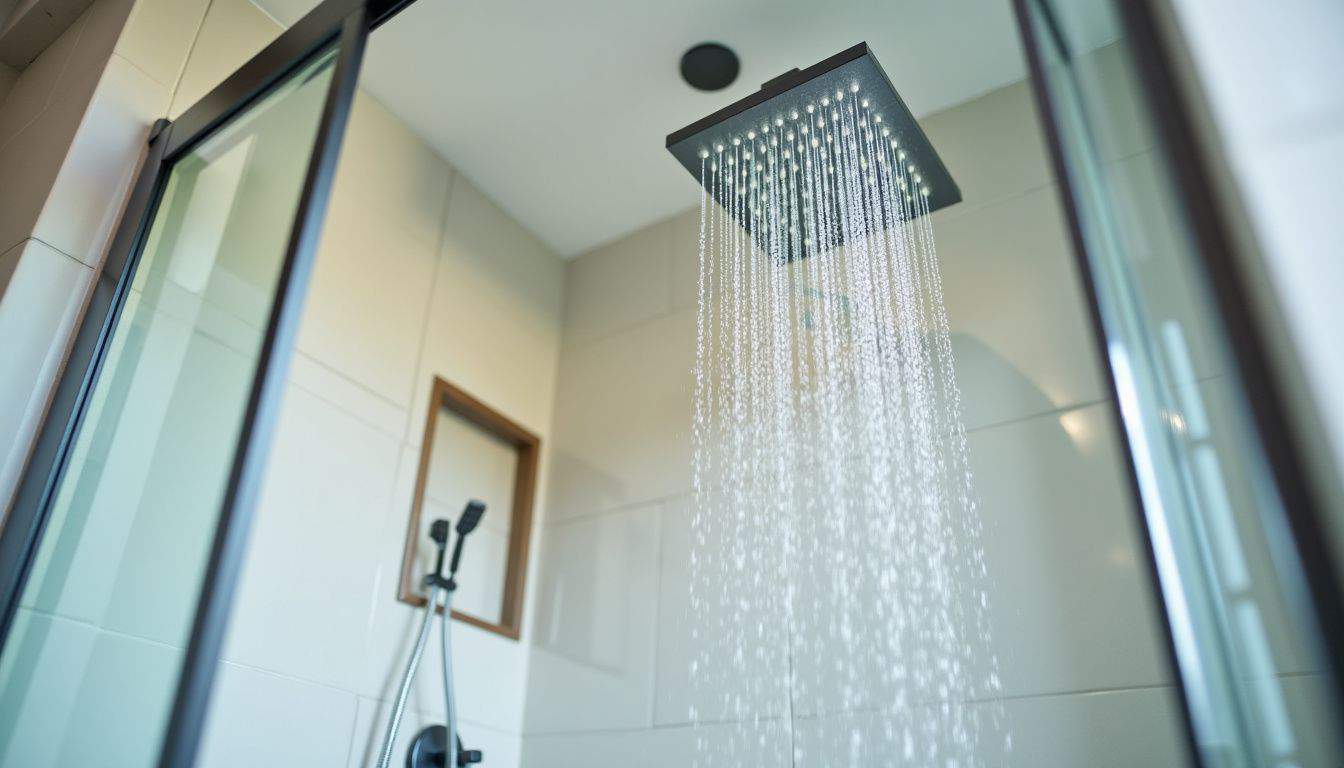
Moving from dual shower heads, let’s talk about rainfall showerheads. These babies are a game-changer! Picture water falling on you like a warm summer rain. It’s pure bliss. Rainfall showerheads are easy to install, too.
You can do it yourself in about an hour, and it’ll cost you around $250. That’s not bad for a major shower upgrade.
The best part? You don’t need to mess with your existing plumbing. These showerheads hook up to your current pipes and valves. No need to tear up walls or call a pro. Just swap out your old head for the new one, and you’re good to go.
It’s a quick way to add a touch of luxury to your daily routine. Trust me, once you try a rainfall shower, you won’t want to go back.
Adding Built-In Seating and Storage

Built-in seating in showers is a game-changer, guys. It’s practical and luxurious. Imagine scrubbing your feet or shaving your legs without doing a balancing act. Plus, it’s great for older folks or anyone who needs a break mid-shower.
Why not add some built-in shelves too? You’ll have a spot for your shampoo, soap, and that fancy face scrub you secretly love.
A well-designed shower is like a good suit – it should fit you perfectly and have room for all your essentials.
Storage in showers is often overlooked, but it’s important. No more clutter or bottles falling on your toes. Smart storage keeps everything close, making your shower time easier. And let’s face it, a clean, organized shower just feels better.
Speaking of better, if you’re thinking about a full bathroom remodel, think about how these features could change your space.
Now, let’s look at some trendy shower enclosures that’ll make your bathroom stand out.
Choices in Shower Tiles and Surfaces

Tiles and surfaces can make or break your shower’s look. From sleek porcelain to eye-catching mosaics, your options are endless. Want to know more about creating a shower that’ll make your jaw drop? Keep reading!
Mosaic Tiles to Enhance Visual Appeal
Mosaic tiles pack a punch in bathroom design. They’re small but mighty, adding depth and interest to your shower space. Glass mosaics come in a rainbow of colors, perfect for creating eye-catching patterns.
Want something more natural? Stone mosaics bring unique textures and an organic feel to your bathroom.
These tiny tiles do big things for your shower’s look. Their small size creates visual depth, making your space feel larger. Mix and match colors for a custom design that pops. Or go monochrome for a sleek, modern vibe.
The options are endless with mosaics – let your creativity flow!
Using Large Format Tiles for a Sleek Look
Mosaic tiles are great, but let’s talk big. Large format tiles are the new cool kid on the block. These bad boys are huge – we’re talking over 12 inches wide or long. They’re perfect for guys who want a clean, modern look without the fuss.
Here’s the deal: big tiles mean fewer grout lines. That’s less scrubbing for you and more time for… well, anything else. Plus, they make your space look bigger. It’s like magic, but it’s just smart design.
I’ve used them in my own bathroom, and trust me, it’s a game-changer. The smooth surface is easy to clean, and it looks damn good too.
Large format tiles are like the superhero of bathroom design – they swoop in and make everything look bigger and better.
Combining Different Materials for Unique Accents
Large format tiles are great for a sleek look, but why stop there? Mix it up! Blending different materials in your shower can create a real eye-catcher. Think about pairing smooth porcelain with rough stone.
Or try matching glossy glass tiles with matte ceramic ones. This combo adds depth and interest to your shower space.
Natural stone and mosaic tiles are popular choices for unique accents. A strip of river rocks along the floor can feel like a mini-massage for your feet. Or add a pop of color with a mosaic tile border.
The key is to play with textures and finishes. This creates a dynamic look that’ll make your shower stand out. Just keep in mind – less is often more when mixing materials.
Trends in Shower Enclosures
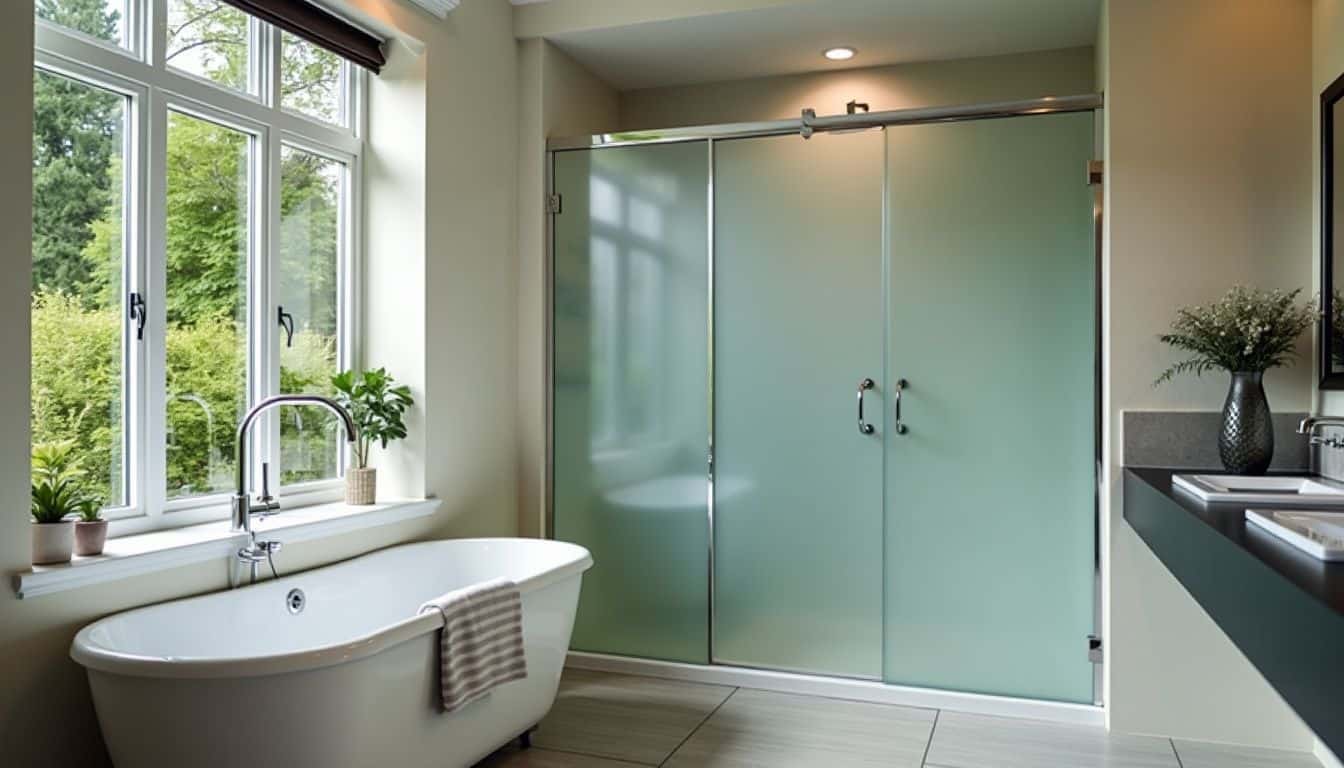
Shower enclosures are getting a major facelift these days. From sleek glass panels to fancy tinted options, there’s a whole world of cool designs to explore.
Installing Frameless Glass Doors
Frameless glass doors are the rock stars of modern showers. They’re sleek, they’re sexy, and they make your bathroom look like a million bucks. No bulky frames or chunky hardware here – just pure, uninterrupted glass that lets light flow freely.
It’s like showering in a crystal-clear waterfall… minus the bears and mosquitoes.
A frameless shower door is the little black dress of bathrooms – timeless and always in style.
But these beauties aren’t just about looks. They’re tough cookies, too. Made from tempered glass, they can take a beating and keep on ticking. Plus, they’re a breeze to clean. No nooks and crannies for soap scum to hide in.
Just a quick wipe, and you’re done. It’s like having a self-cleaning shower… almost.
Exploring Tinted and Textured Glass Options
Tinted and textured glass options can take your shower to the next level. These cool choices add style and privacy to your bathroom inspiration.
Tinted glass comes in many shades – from subtle blues to bold greens. It blocks prying eyes while still letting light through. Textured glass has patterns or designs etched into it.
This creates a unique look and feel. Plus, it hides water spots and fingerprints better than clear glass.
Glass with texture or tint isn’t just for looks. It also blocks harmful UV rays. This makes your bathroom safer and helps protect your skin. Some guys even say it feels like showering in a fancy hotel.
Whether you go for a light frost or deep ocean blue, these glass options can transform your everyday shower into something special. Just pick a style that fits your taste and budget.
Designs for Curved and Angled Enclosures
Glass isn’t just for windows anymore. Curved and angled shower enclosures are taking bathrooms by storm. These sleek designs do more than just look cool. They make your space feel bigger and work better.
I’ve seen firsthand how a curved frame can open up a tiny bathroom. It’s like magic – suddenly there’s room to move!
Corner showers are a game-changer for small spaces. They fit snugly where two walls meet, saving precious floor space. Triangular or curved shapes squeeze every inch of use out of tight spots.
Plus, they add a modern touch that’ll make your bathroom the envy of the block. Trust me, once you go curved, you’ll never want to go back to boring old squares.
Tailored Shower Designs for Specific Needs

Showers aren’t one-size-fits-all. Some folks want an outdoor rinse after a beach day, while others crave a steamy spa experience right at home.
Integrating Outdoor Showers
Outdoor showers bring a touch of luxury to your backyard. They’re perfect for rinsing off after a swim or washing away sand from the beach. Picture stepping out of your pool and into a refreshing spray under the open sky.
It’s like having your own private oasis right at home.
These showers don’t have to be fancy. A simple setup with good water pressure does the trick. But if you want to go all out, add some teak flooring or natural stone tiles. Don’t forget about privacy – tall plants or a wooden screen can keep prying eyes away.
Next up, let’s talk about designing steam showers for health perks.
Designing Steam Showers for Health Benefits
Steam showers pack a punch for your health. They cut stress, boost blood flow, and help you breathe easier. Plus, they’re great for your skin and can even burn calories. To get the most out of your steam shower, you’ll need a few key things.
First, grab a steam generator – it’s the heart of the system. Don’t forget a comfy seat to relax on while you steam. Good lighting is a must, too. It sets the mood and helps you unwind.
Want to take it up a notch? Try adding some extras. Aromatherapy can make your steam session smell amazing. Or go for chromotherapy – it uses colored lights to boost your mood. These add-ons can turn your shower into a mini spa.
Just imagine stepping into your own personal health haven every day. It’s like having a wellness retreat right in your bathroom.
Conceptualizing Open Concept Showers
Moving from steam showers, let’s check out open concept showers. These are the stars of modern bathrooms. They get rid of walls and doors, making things sleek and spacious. You step into your shower area with no barriers.
It’s like showering outdoors… minus the bugs and nosy neighbors.
Open showers aren’t just cool – they’re clever too. They make your bathroom feel bigger and brighter. But here’s the thing: you need a good plan to keep water in check. Sloped floors and linear drains are your best friends here.
They guide water away smoothly, no puddles allowed. It’s about mixing style with smarts, guys. Your bathroom will thank you… and so will your feet when they’re not splashing in surprise pools.
Ensuring Accessibility and Convenience in Showers

Showers should work for everyone – no matter their age or abilities. We’ve got some cool ideas to make your shower safer and easier to use. Want to know more? Keep reading!
Installing Barrier-Free Walk-In Showers
Barrier-free walk-in showers are a game-changer for guys who want easy access. No more stepping over high tub walls or tripping on thresholds. These showers are smooth sailing from floor to ceiling.
You can roll right in with a wheelchair or walker if needed. But don’t think they’re just for folks with mobility issues. Anyone can enjoy the sleek, open look.
Want to make your shower pop? Go wild with colors and patterns. Pick bold tiles or add a funky accent wall. The sky’s the limit with design options. And hey, you can still add cool features like rain showerheads or built-in benches.
It’s all about creating a space that works for you and looks awesome too. Trust me, once you try a barrier-free shower, you’ll wonder how you ever lived without one.
Low-Threshold Showers for Easy Access
Low-threshold showers are a game-changer for easy access. These showers have a small lip or no lip at all, making it a breeze to step in and out. No more tripping hazards or high barriers to climb over! They’re perfect for folks who want to age in place or those with mobility issues.
I installed one in my dad’s bathroom last year, and he loves it. The smooth transition from floor to shower is not just practical – it looks sleek too.
These showers aren’t just about function; they can be stylish as well. You can deck them out with cool tiles, fancy showerheads, and even built-in benches. My buddy Jake added a rainfall showerhead to his low-threshold setup, and now he feels like he’s at a spa every morning.
Plus, these showers are easier to clean – no nooks and crannies where grime can hide. It’s a win-win for comfort and maintenance.
Safety Features: Grab Bars and Non-Slip Surfaces
Low-threshold showers are great, but safety doesn’t stop there. Let’s talk about grab bars and non-slip surfaces. These features are like your bathroom’s secret weapons. They keep you steady on your feet and boost your confidence.
Grab bars are a must-have. Put them on at least two walls, 33 to 36 inches from the floor. They should hold up to 250 pounds – that’s some serious strength!
Now, let’s chat about floors. Slippery tiles are a no-go. You need surfaces that grip, even when wet. Think textured tiles or special coatings. It’s like giving your feet tiny suction cups.
I once slipped in a hotel shower – not fun. Since then, I’ve made sure my bathroom floor is as grippy as a race car tire. Trust me, it’s worth it. These simple changes can turn your shower into a safe haven.
No more worrying about slips and falls. Just pure, relaxing shower time.
People Also Ask
How can I make my bathroom shower feel more luxurious?
To add a touch of luxury to your bathroom shower, consider installing a clawfoot tub or using high-end porcelain tiles. A well-chosen color scheme can work wonders too. Think about adding skylights for natural light or fancy countertops for a posh look. Remember, it’s all in the details!
What are some cozy bathroom shower ideas?
For a cozy vibe, try warm ceramic tiles and soft lighting. Add some comfy decor like plush towels or a small wooden stool. A rain showerhead can make your daily rinse feel like a spa day. Don’t forget about storage – smart cabinetry can keep things tidy and inviting.
How can I make my small bathroom shower look bigger?
It’s all about playing with perception. Light colors on walls and floors can open up the space. Large mirrors are your best friend here. Glass shower doors instead of curtains can make the room feel more open. Clever storage solutions will keep clutter at bay, making the space feel larger.
What are some trendy bathroom shower ideas for 2023?
This year, it’s all about bold choices. Think dark, moody color schemes paired with brass fixtures. Patterned tiles are making a splash too. Smart showers with digital controls are hot right now. And don’t forget about sustainability – low-flow showerheads and eco-friendly materials are very in vogue.
References
https://modernize.com/homeowner-resources/bathroom/corner-shower-ideas
https://www.bhg.com/bathroom/shower-bath/walk-in-showers-for-small-bathrooms/ (2024-07-11)
https://www.housebeautiful.com/room-decorating/bathrooms/tips/g1441/small-bathrooms-ideas/ (2024-09-12)
https://www.yahoo.com/lifestyle/15-stunning-small-bathroom-shower-223500460.html
https://www.fontanashowers.com/Luxury-Showers-With-Multiple-Shower-Heads-p/fs1339dp.htm
https://www.youtube.com/watch?v=9OT0Ttu7XrE
https://civicscience.com/this-years-bathroom-upgrades-feature-luxury-showerheads/
https://www.kallista.com/articles/walk-in-shower-design-ideas (2022-07-20)
https://www.bhg.com/bathroom/shower-bath/walk-in-showers/ (2023-01-27)
https://www.re-thinkingthefuture.com/articles/mosaic-tiles-in-bathroom-design/
https://savannahsurfaces.com/2019/08/15/creating-a-modern-bathroom-design-with-mosaic-tiles/ (2019-08-15)
https://www.youtube.com/watch?v=frIPKt5gIEg
https://degnandesignbuildremodel.com/blog/the-pros-and-cons-of-using-large-format-tile-in-a-bathroom-remodel (2024-03-20)
https://www.housebeautiful.com/room-decorating/bathrooms/g3414/bathroom-tile-ideas/ (2024-06-26)
https://www.glassartdesign.com/2023/01/latest-trends-in-glass-shower-enclosures/ (2023-01-27)
https://www.glassmagazine.com/article/safe-beautiful-frameless (2022-03-11)
https://www.housebeautiful.com/room-decorating/bathrooms/g38006706/glass-shower-door-ideas/ (2021-11-18)
https://www.goodhousekeeping.com/home/decorating-ideas/g38560382/walk-in-shower-ideas/ (2023-04-28)
https://www.hgtv.com/outdoors/outdoor-spaces/design-ideas-outdoor-showers-and-tubs-pictures
https://centsationalstyle.com/2024/04/outdoor-shower-designs/ (2024-04-22)
https://www.articulated.studio/blog/steam-showers-wk-4-one-room-challenge
https://www.pioneer.glass/custom-steam-showers-transforming-bathrooms-into-spas/
https://phxhomeremodeling.com/open-concept-showers/ (2024-01-15)
https://mastershomesolutions.com/barrier-free-showers/
https://continuingeducation.bnpmedia.com/article_print.php?C=2665
https://www.affordablewalkinshower.com/
https://dickeys-inc.com/walk-in-showers-for-accessible-bathrooms-enhancing-safety-and-convenience/

